top of page
Sellers and Company
The articles in the last two months have dealt with makers of big machines in the Baldwin Park neighborhood; this article continues that theme. There was an iron works on the two blocks south of the third United States Mint building, run by a family that had connections to artists Charles Wilson Peale and Thomas Eakins, writer Mark Twain, and the man considered the father of scientific industrial management. The connection to art, photography, and movies was previously discussed in our article here. This article will look at the factories and give more detail on a family that had arguably more art and science leadership roles than any other family in Philadelphia.

Lithograph from 1868 book looking east toward the Sellers factory complex.
17th Street is in the foreground. Hamilton Street bisects the image. The narrow building along the rail tracks on Pennsylvania Avenue on the right is the Asa Whitney Wheel Works.
The low slung building on far left with the multiple chimneys was the blacksmith shop for the Norris Locomotive Works, which abandoned the site in 1866. The pair of white buildings on the left in this image was also part of the Norris Works before acquisition by Sellers. The Sellers also owned 3/4 of the block between 15th and 16th and Hamilton and Buttonwood, occupied by the one-story white building on the northeast corner of Hamilton and 16th seen here.
The erecting shop is in the lower right corner of the complex.

Detail of 1888 map here showing the William Sellers Iron Works occupying the two blocks south of what is now the Mint Building at the Community College of Philadelphia. Borders of the Sellers Company are Buttonwood Street to the north, the railroad running at ground level on Pennsylvania Avenue to the south, 16th Street to the east, and 17th Street to the west.
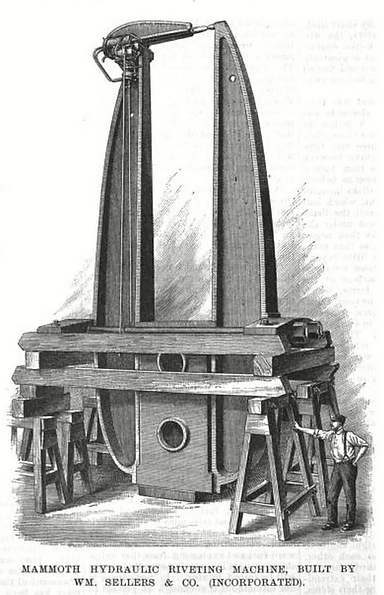

Sellers built huge machines to make other huge machines. These two images are from the 1895 catalog here.
You can view a 7-minute video from 1919 here showing a smaller version of the steam hammer in action at the Midvale Steel Company. Guys, get some eye protection! Watching the video will make you appreciate your current job, no matter how bad you think it is.
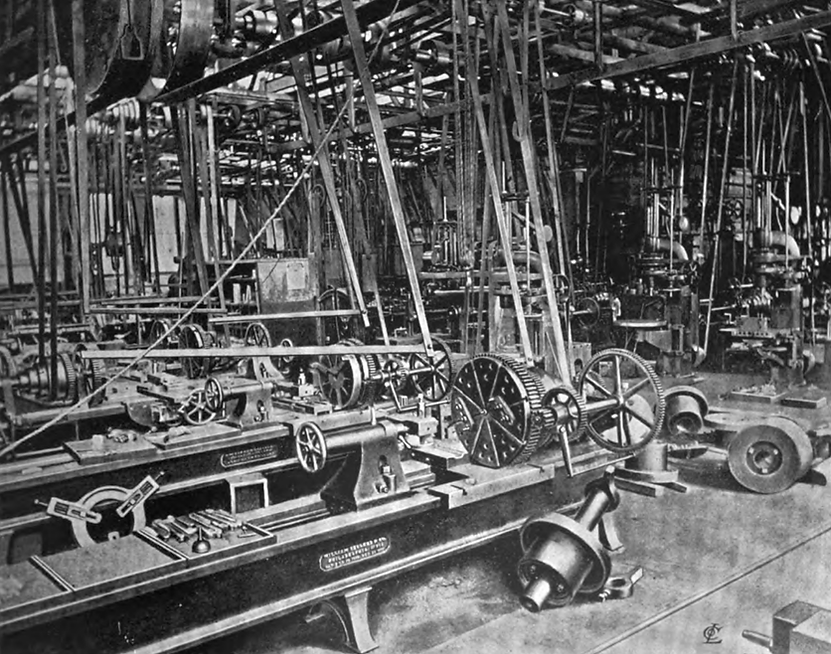
The Sellers Iron Works factory floor around 1890.
Sellers had a huge share of the national shafting market. The photo shows the drive belts connected to the iron shafting along the ceiling. The wheels on the shafting were powered by a powerful steam engine. The centralized steam engines would eventually be replaced by individual electric motors at each machine.
You can visit a small-scale version of such shafting at the nearby Carpenters Museum, as discussed in our article here.
William Sellers is best known internationally for presenting a paper at the Franklin Institute in 1864, advocating for a standardization of the screw thread design to make them all compatible no matter the manufacturer. This plan was adopted in the United States, but not until 1901 in Europe. England, being England, stuck with the Whitworth standard developed in England. This changed after the war in North Africa in 1942. Desert sand wore out the bolts and nuts on British tanks, and the United States was a major Allied military parts supplier. American nuts did not fit British bolts, and the disabled tanks stayed disabled. For the rest of the war, American factories began running parallel assembly lines, one for turning out engines and weapons compatible with the Sellers standard and one compatible with the Whitworth standard. In 1948, Britain finally adopted the Sellers, or US, standard.
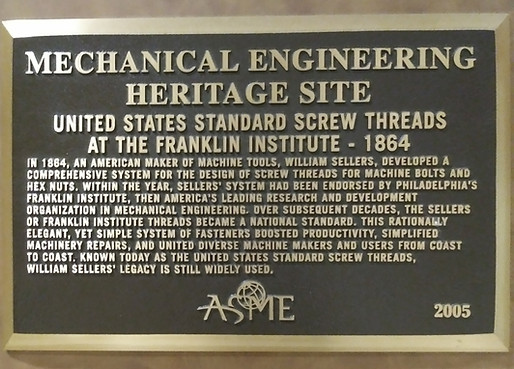
Plaque on the first floor of the Franklin Institute, next to the elevators.

The Sellers family had hundreds of patents.
This 2019 photo shows a model of a Sellers Oscillating Engine made for patent acquisition. The model is on display at the Smithsonian Museum of American History in Washington DC. Early patent applications for machinery required submission of a physical model.
Coleman and William Sellers had tinkered with engines, and even locomotives, early in their careers.

Steam generated in boilers was used to move pistons, and the up and down motion of pistons was converted into circular motion for use in locomotives and factories. The higher the pressure of the steam in the boiler, the better the efficiency. Water had to be forced into the boiler to replace the steam released, and this Sellers autoinjector, based on one built in 1887, controlled the water input.
This 2019 photo shows the Sellers product on display at the Smithsonian Museum of American History in Washington DC. The first floor of this museum has many examples of American inventions arising from our neighborhood. For other Smithsonian objects from our neighborhood, see here.

Sellers was a national player.
In 1869 Sellers took out this full-page ad in the Union Pacific 64-page commemorative book marking the completion of the Transcontinental Railroad. The Union Pacific had completed the eastern half of the railroad.

Sellers Iron Works made locomotive turntables and sold them throughout the world. This 1895 photo looking east shows the turntable on the surface railroad at Hamilton and 20th Streets. This line would be lowered in 1898 and the turntable moved one block west. William Sellers was the only person who testified in City Council in opposition to digging what is now called the Callowhill Cut.
By 2021 the relocated turntable site will be covered by the new construction of 2100 Hamilton Condominiums.
The Sellers family has deep roots in Philadelphia. Samuel Sellers and his brother bought 100 acres in what is now Darby in 1682, having arrived from England with William Penn. The family purchased 75 more acres and in 1757 John Sellers, grandson of Samuel, erected a flour mill on a dam they built across Mill Creek (now called Cobb's Creek). The mill, called somewhat redundantly Millbourne Mills ("bourne" meaning creek), would lend its name to the Sellers estate. This mill was in operation until 1927, and the flour from the mill was sold under the brand name King Midas Flour.
By 1897, a great-grandson of the above named John Sellers, William Sellers, had acquired the 200-year-old homestead. He himself had worked in machine shops in Wilmington, Delaware, and Providence, Rhode Island, prior to establishing a machine shop, with partner and brother-in-law Edward Bancroft (1811-1855), in Philadelphia in 1848. By 1897 he, having been joined by his cousin Coleman Sellers Jr., owned one of the largest machine and shafting shops in the country. Both William and Coleman were influential at the Franklin Institute, as discussed in our article here, and through the Franklin Institute standardized the machining of screw threads. For more on the Sellers family, see the Wikipedia entry here.
Eventually the Millbourne estate would separate from Upper Darby in 1909 and become the tiny (45 acre) borough of Millbourne in Delaware County, just across Cobb's Creek from Philadelphia. The Millbourne SEPTA Station on the Market-Frankford Line is the penultimate stop on the line going west.

Portion of 1687 map with blue arrow showing Samuel Sellers' land on Mill Creek, now Cobbs Creek.

The redesigned mill of John Sellers III appears on this float from the 1887 Civic and Industrial Display of Philadelphia. In 1816 Sellers entered into a licensing agreement with Oliver Evans to automate the mill. Image from 24-page commemorative booklet here.

Millbourne, part of the Sellers estate in Darby, owned in 1897 by William Sellers.
He divided it for two tenants and he himself lived at 1819 Vine Street, seen below.
Like our own Matthias Baldwin, members of the Sellers family were abolitionists. The Sellers estate was a significant stop on the Underground Railroad.
Darby has many remnants of the various Sellers family subdivisions, and some history of the Sellers there is discussed in an 1897 book here.
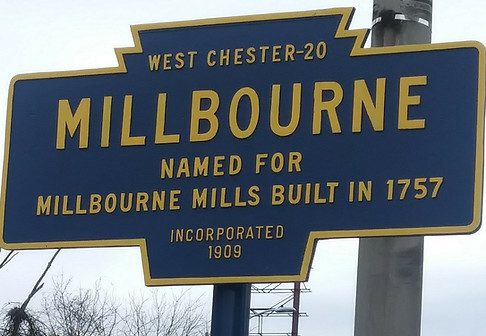
Sign on Market Street noting entrance into Millbourne from the east.

The great-grandsons of Samuel Sellers were the first to move into Philadelphia from Darby. Brothers David and Nathan had a wire shop on Market Street near 6th Street, and their grandchildren would take up metal work, and even dabble in locomotive construction. This sidewalk plaque is right outside the Market Street entrance for the Independence Hall Visitor Center. Coleman was the grandson of Nathan, and William was the grandson of Nathan's brother John II. Though officially second cousins (having the same great-grandfather), they were genetically as close as first cousins, since David, Nathan, and John II married three sisters.
The Sellers name is alive and well, including an actress on the HBO show Game of Thrones who played a Sand Snake for three seasons.

Photo from 1900 of the home of William Sellers at 1819 Vine Street on fashionable Logan Square. This site is now occupied by the former family court building.
Coleman Sellers lived at 17th and Mount Vernon Streets in the northeast corner house that still stands.
In 1873 Mark Twain wrote his first novel, and his only novel with a coauthor, his Hartford, Connecticut neighbor Charles Warner. Twain coined the term "Gilded Age" in the book with that same title. Despite the promise of prosperity via industrialization, Twain took a dim view of the materialism, land speculation, and corruption that accompanied it. One character in the story was Eschol Sellers, a flamboyant but genial con man who was always diving into risky ventures. Twain adapted the book into one of his few successful plays, titled Colonel Sellers.
After the publication of the first edition of the book, the brother of Coleman Sellers, George Escol Sellers, took exception to the portrayal of such a character bearing his name. He sued Twain for libel, so that the next editions had the names Beriah Sellers (until a real Beriah Sellers also sued), and then Mulberry Sellers. Twain enjoyed tweaking his adversaries, so of course the name Mulberry Sellers may have had some connections to George Escol Sellers' birth in Mulberry Court, Philadelphia (near 7th and Market). For hard-core Twain fans, see more at outside link here.

Photo showing Mark Twain on the right and the actor John T. Raymond portraying Colonel Sellers in the play based on Twain's book The Gilded Age.
In 1873 William Sellers took over a much larger steel plant in the Nicetown section of Philadelphia. This plant made much of the steel placed in bridges and also ramped up to make munitions in the world wars. It was there in the 1880's that Frederick Winslow Taylor, now considered the father of scientific management, pulled out his stopwatch and began studying the motions of men and machines with the goal of improving efficiency. There were as yet few unions, and one way the workers gained control, so management thought, was to work themselves and the machines at the slowest pace that would avoid punishment. In 1911 Taylor put his ideas together in a book, The Principles of Scientific Management, and his ideas of time-and-motion-studies, best practices, and "working smarter not harder," still plague our management lingo today.
Aside: another scientific management pioneer in the near-neighborhood was Charles Day (1879-1931). He worked in mechanical and civil engineering and joined with James Dodge in 1901 to form Dodge and Day, specializing in engineering and management. They were joined by John Zimmerman in 1907. When Dodge withdrew as partner in 1911, the firm became Day and Zimmerman, incorporated in 1916, expanded to 150 locations worldwide, and is now headquartered at 1500 Hamilton Street.

Hexamer insurance map from 1879 of the Midvale Steel Works, where Taylor developed the field of industrial engineering.
The plant itself would ultimately be acquired by Heppenstall Steel Company of Pittsburgh in 1956; be torn down in the early 1980's; and two decades later become today's SEPTA bus depot and maintenance yard. You can view here a 1919 eleven-minute silent video of the Midvale plant that has post-apocalypse written all over it.

Panorama of the Midvale plant in 1927.
The Budd plant was adjoining and the water tower with "Budd" spelled out can be seen in bottom left.
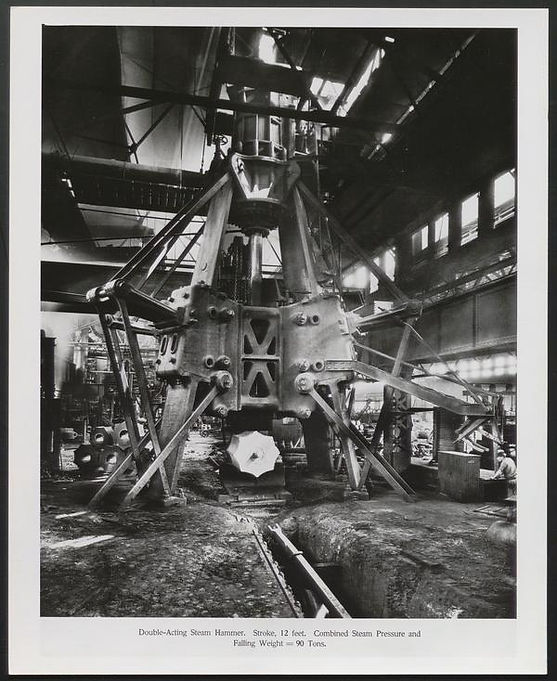
Bigger spaces allowed construction of bigger machines at Midvale.
There is a human figure in the lower right of this image from 1905.
In 1943 the Sellers company was sold to Consolidated Machine Tools of Rochester, New York, for $1.1 million, the equivalent of $16 million today. The local plant was then closed. The Sellers' blocks in our neighborhood were sold to the Gulf Distilling Company in 1947. The buildings in our neighborhood served briefly as warehouses before being demolished for parking by 1965.
There are a few remnants of the prior industrial might in our neighborhood. The Callowhill Cut is the most obvious. There is also the rail siding under the Tivoli as well as the siding ramps up to the granary and the former Knickerbocker Ice Company at the 2100 Hamilton building site. The most singular in my opinion is the bridge to nowhere across the Cut, between 16th and 17th Streets, that in years past allowed rail access directly into the Sellers factory.

Sketch of the William Sellers & Company Iron Works in 1888.
The train on the right can be seen chugging west on Pennsylvania Avenue, which would not be submerged into the Callowhill Cut until 1898. 17th Street is in the foreground, with north to the left. The pedestrian bridge over Hamilton Street connects the buildings. I believe some imagination was used in this sketch, as the erecting shop in the southwest corner of the factory complex was always a squat structure with a hip roof and cupola, as seen in the sketch from 1868, as well as the photos from 1899 and 1955.
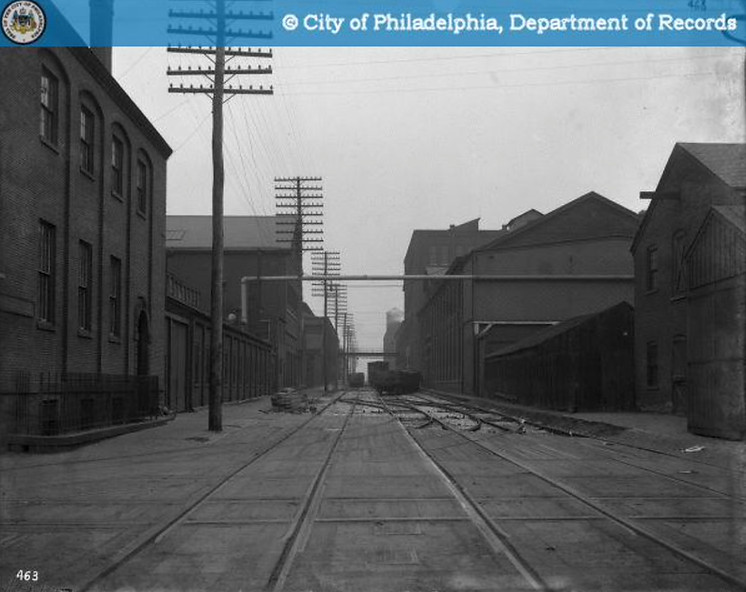
A view in 1897 west on Hamilton Street from around 15th Street.
The Sellers pedestrian bridge over Hamilton Street can be seen in the distance.
All the manufacturing plants had to keep functioning while the tracks on Pennsylvania Avenue were being submerged. Temporary tracks were placed along Hamilton Street parallel to Pennsylvania Avenue.

The Sellers plant from the southeast in 1899.
The access bridge into the plant is on a diagonal over the Callowhill Cut.
The abandoned Asa Whitney & Sons Car Wheel Works, having gone bankrupt in 1891, is on the left. The Reading Railroad bought the Whitney property to accommodate the ramp and bridge into the Sellers plant.
The wooden granary is at back center-left.

Same view as above in 1940, after completion of the Lit Brothers warehouse (the building without the soot).

Photo from 1955 looking north on 17th at the neglected former erecting shop of the Sellers complex.
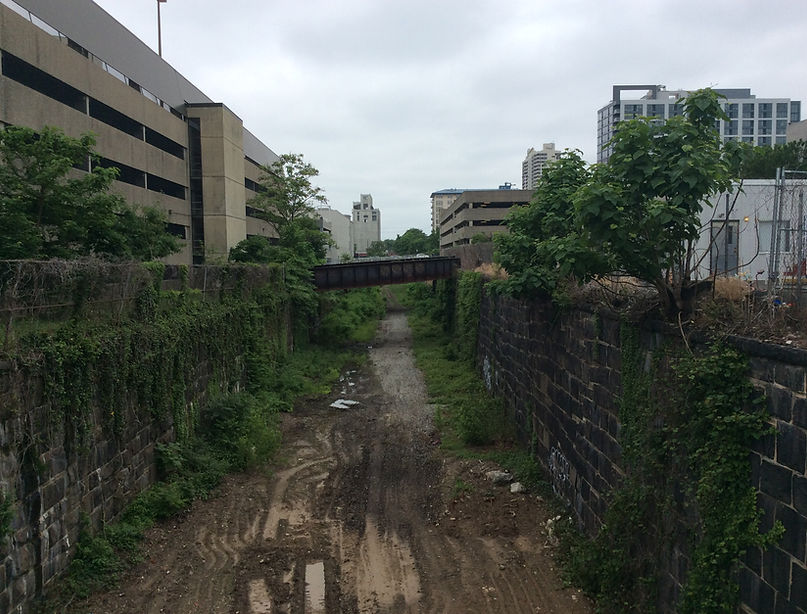
Lonely bridge into the former supplier of steel for bridges

Surface of the bridge in April 2020. The iron rails have been removed, but besides that, it doesn't look good for locomotive travel!

The underside of the Sellers bridge in 2020.
The wood is decaying, but the steel I-beams are in great shape for a 120-year-old bridge. The bridges over the Cut on the numbered streets in the neighborhood, first built in 1898 like the Sellers bridge, were all replaced in the 1950's and 1960's.
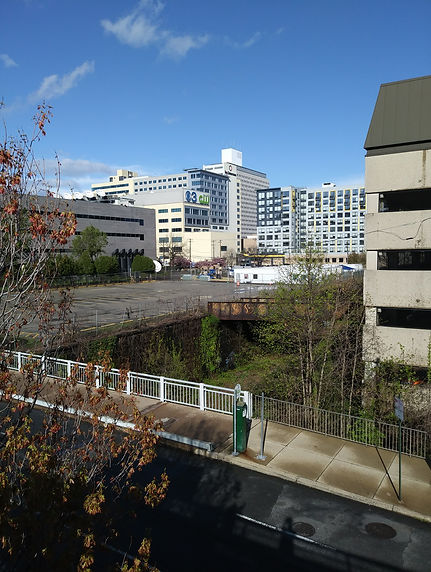
Looking from the southwest across 17th Street today.
The southern half of the Sellers complex is now a surface parking lot on Community College of Philadelphia's campus. The parking garage on the right is the site of Asa Whitney's Wheel Works.
Coleman Sellers Jr. was a Franklin-esqe figure in the second half of the 19th century: he was everywhere and into everything. His relation to Charles Wilson Peale and his mentoring of Thomas Eakins were discussed in our article here. He took many of the photos of the machines for the Sellers catalog, as well as landscape photos in the 1860's, as seen in the Library of Congress site here. Just as Benjamin Franklin was part of a nine-member commission that debunked mesmerism (animal magnetism) in 1784, Coleman Sellers was part of the ten-member Seybert Commission that debunked spiritualism in 1884 (outside link here). Also, as Franklin was involved with electricity, Coleman oversaw the hydroelectric development at Niagara Falls. He could be considered the first president of the Philadelphia Museum of Art, as the following history suggests. In 1876, at the end of the Centennial Exhibition in west Fairmount Park, Memorial Hall became the Pennsylvania Museum and School of Industrial Art, of which Coleman was the first president. In 1938 the museum component changed its name to the Philadelphia Museum of Art and the school became the Philadelphia Museum School of Industrial Art. In 1964 the school separated from the museum and became the Philadelphia College of Art, and then the University of the Arts in 1987.

Memorial Hall in 1878, then called the Pennsylvania Museum and School of Industrial Arts. Image from 1876 first annual report here.
Coleman Sellers did big projects like at Niagara Falls, but he also was helpful locally with smaller innovations. The Women's Pennsylvania Society for the Prevention of Cruelty to Animals (WPSCPA) was founded by Caroline Earle White in 1869. The group arose out of the horrible conditions for work horses, animals in abattoirs, and sheltered dogs. In the late 1800's rabies in humans was uncommon, but deaths were agonizing and inevitable. Stray dogs were rounded up, and if not recovered by the owner in two days, clubbed to death. The WPSPCA consulted Coleman Sellers, then President of the Franklin Institute, to develop a method of humane euthanasia for the unwanted dogs. Coleman popularized a system in which dogs in a box of dimensions 11 feet by 6 feet would be put to sleep using carbon monoxide (then called carbonic acid), chemically synthesized in a stove atop the box.
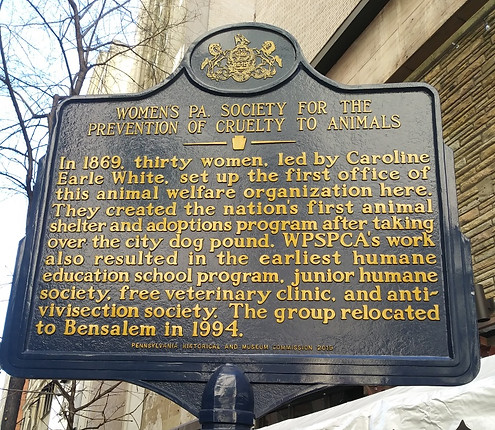
Historical plaque on the south side of the 1300 block of Chestnut Street.

Coleman's invention for the "painless extinction of life."

Another remnant of the Sellers' family within the city proper:
After the Civil War Coleman Sellers moved from the northeast corner of 18th and Mount Vernon Streets one mile away to 3301 Baring Street in West Philadelphia, outside of which is a neighborhood historical marker. Other Sellers family members lived on this street as well, including his cousin, across the street.


Mary Sellers Bancroft, widow of Edward Bancroft, sister of William Sellers, and cousin of Coleman, had this house built in 1870 across the street from Coleman's in Powelton Village. It is now the charming Cornerstone B&B.
Mary was the grandmother of American painter Maxfield Parrish (think Tiffany mosaic in the Curtis Building) and was a founding member of the West Philadelphia Hospital for Women.
For more on this block, and Twain's abuse of Escol Sellers, see outside link here.

A family affair in Powelton:
In the 1880s John Sellers Jr., brother of William Sellers, developed and sold these Queen Anne-style homes from 3306 to 3320 Arch Street near Powelton Village. These were single family homes when placed on the Philadelphia Register of Historic Places in 1987. They are now apartments. John Sellers Jr. lived with his family at 3300 Arch Street, a building that has been demolished.
This photo is facing southwest in 2025.
authored by Joe Walsh, December 2020
updated February 2025
bottom of page


